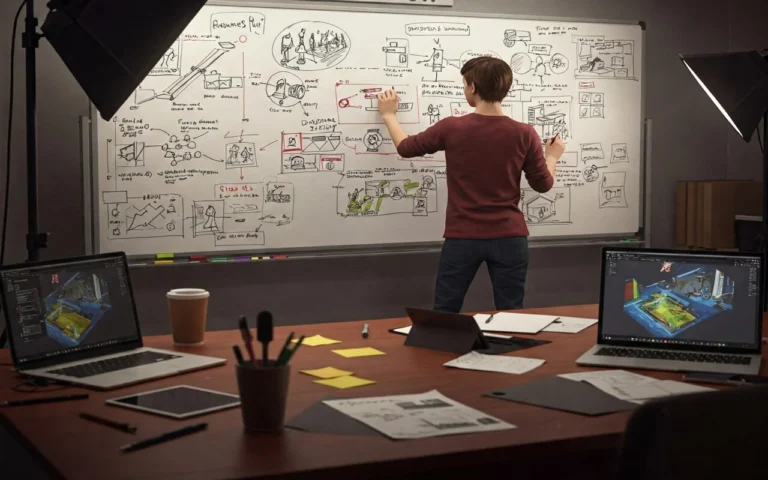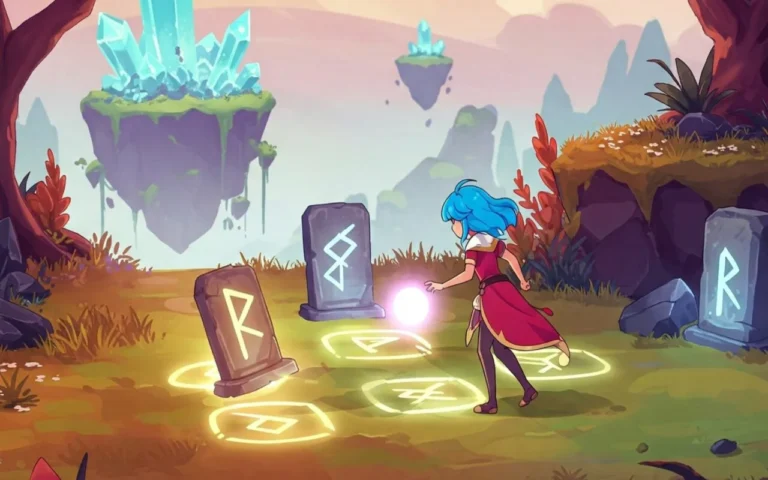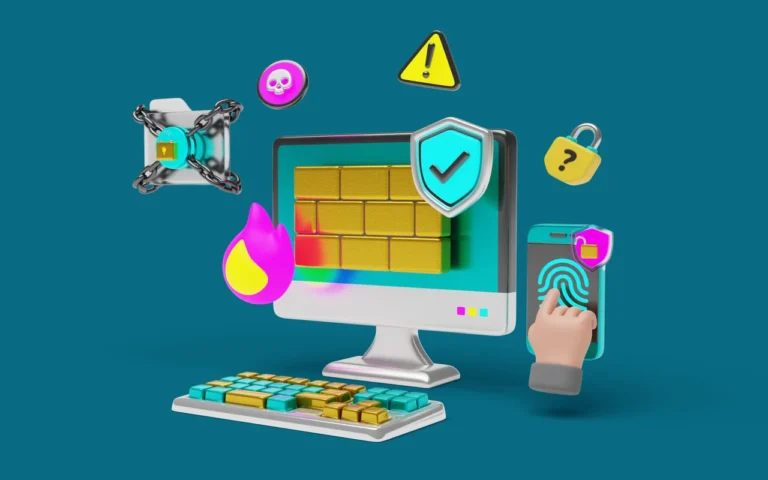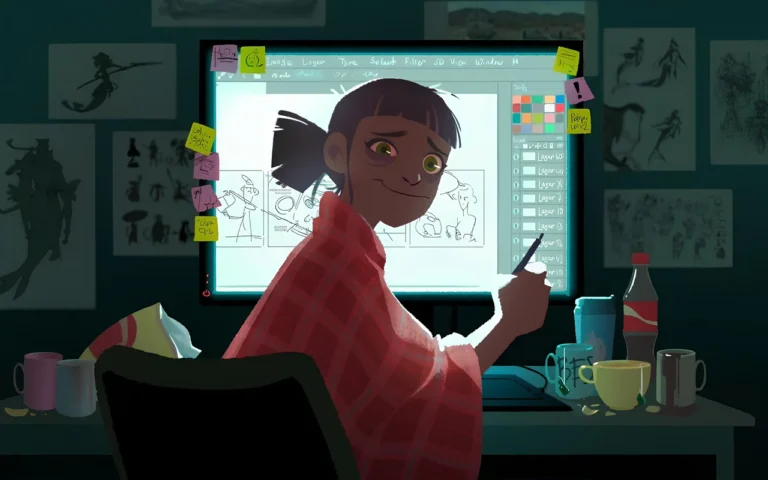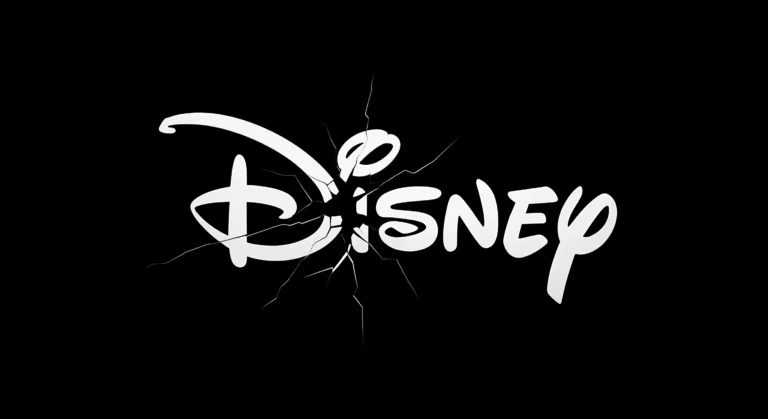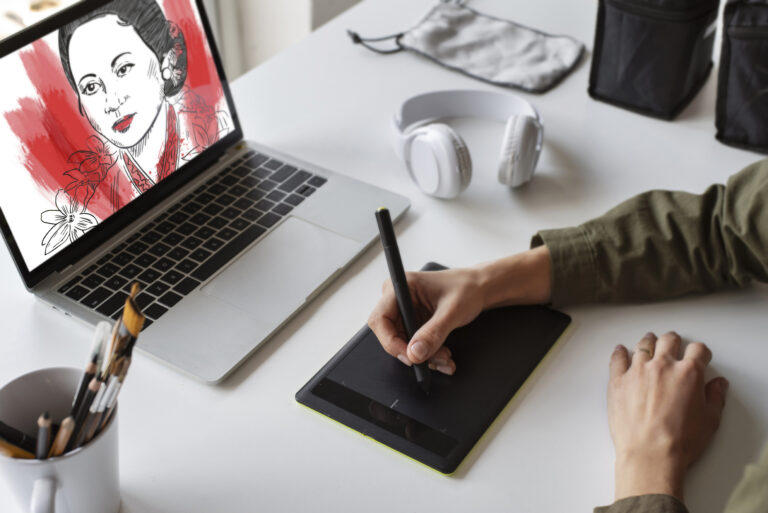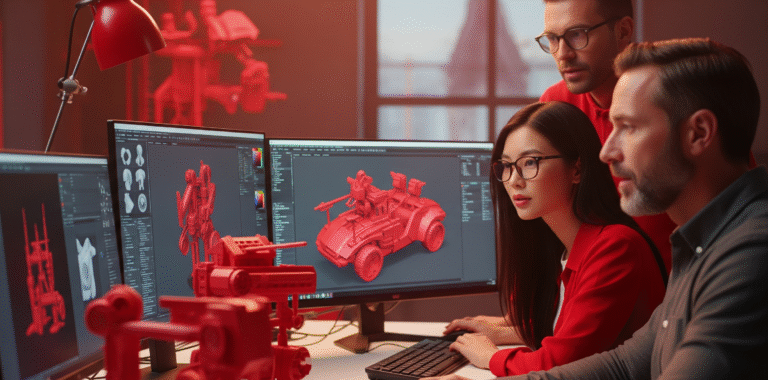Storyboarding turns your thoughts into pictures that help your team find issues before they cost any money. Plus, it helps your message get across clearly, keeps you from having to pay for expensive re-do, and lets you try out different camera angles before anyone clicks the shutter.
But it’s not all good news. Storyboarding takes time and drawing skills, and smaller teams may not have the people or money to do it.
Besides that, storyboards don’t always do a good job of showing how fancy the camera moves, perfect timing, and the way lighting changes a scene in the real movie.

Need Animation Services?
Visit our Animation Service page to see how we can help bring your ideas to life!
Top 5 Advantages of Storyboards
Storyboard services help teams visualize projects before spending big money and time on production. Here are all the benefits of storyboarding
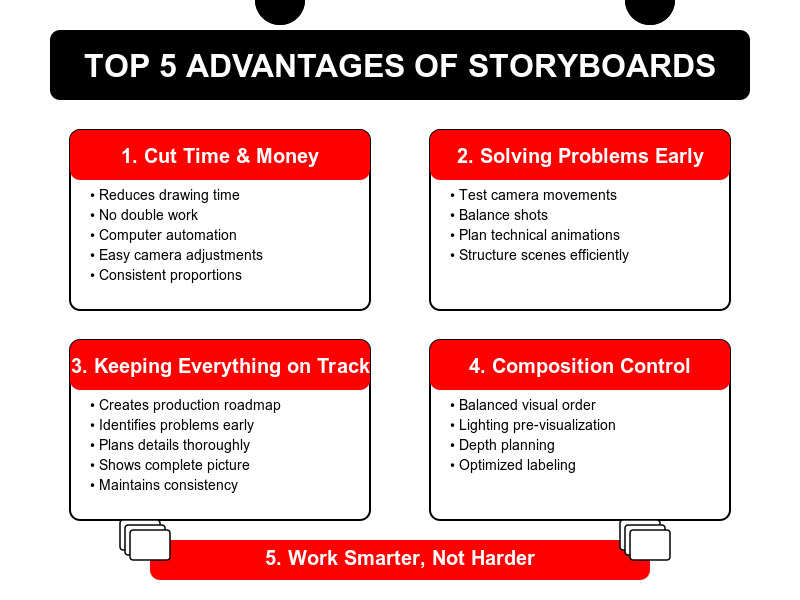
1- Cut Time & Budget with 3D Storyboarding
It is hard to go from hand-drawn storyboards to 3D animation services. So Gouvatsos (2018) came up with a better solution; include 3D in the storyboarding process from the start!
- Draw significantly less: Instant access to basic 3D models saves artists time by cutting down on the number of drawings they have to make.
- No Double Work: There’s no need to build everything twice because those early models go straight into production.
- Computer Does Most of the Work: The system can use your drawings to make character placeholders and order shots based on your script.
- Shifting the camera is easy: Looking for a different view? You don’t have to redo the whole scene; just move the camera.
- Fits perfectly: Every scene has the same size and shape for characters and items, so you never have to wonder, “why is that door suddenly so big?”
2- Solving Problems Through Storyboarding
Stefanie Joelle Okemow says storyboards are basically about fixing problems early to save time and cash during production.
- Test Those Camera Moves: Okemow points out you can try different camera tricks in storyboards. “Zooms work great when you need to get super close to something tiny.
- Balance Your Shots: You can play with lighting depth, and insert shots during storyboarding to make everything look better balanced before actual production starts.
- Plan Medical Animations Right: Storyboards let you plan for both accuracy and good looks for technical stuff like medical animations with “strict and specific rules.”
- Structure Your Scenes Smart: As Okemow explains, “Each small drawing is part of what we call a shot, and shots connect to create scenes,” which helps plan the whole animation efficiently.
3- Keeping Everything on Track
Storyboarding gives production the framework it needs to run easily. In fact, it makes a plan for everyone before the pricey work starts.
- Creates a roadmap: storyboarding saves 10 minutes of production time for every minute spent on it. The movie “Lord of the Rings” was successful because Peter Jackson planned out the whole drama using storyboards.
- Finds problems early: Pixar’s storyboards for “Finding Nemo” showed problems with the lights underwater that were fixed before the movie was animated, which saved the company $3 million.
- Plans every little thing: Nolan used storyboards to make sure that the three timelines (week, day, and hour) in “Dunkirk” all fit together perfectly.
- Shows the whole picture: 2,500 storyboards were used to plan the action in “The Avengers: Battle of New York,” which included many heroes and real-life shooting alongside CGI.
- Keeps things in order: TV directors only have 7-8 days to make a show, and storyboards help them shoot 25–30 setups every day to meet tight deadlines.
- Maintains consistency: With 150 team members, a movie set costs $100,000 a day, and storyboards keep everyone on the same page and stop mistakes that cost a lot of money.
4- Composition Control With Storyboarding
Stefanie Joelle Okemow writes about how storyboarding gives you exact control over the visual design in her part from “Advances in Experimental Medicine and Biology” (volume 1235). With this power, storyboard artists can plan out visual features before they start making them.
- Balanced Visual Order: Storyboards let artists set up a visual order that helps viewers focus on the most important parts.
- Lighting Pre-Visualization: Testing lighting in storyboards saves time and money by avoiding having to make changes during rendering.
- Depth Planning: Planning depth in storyboards makes them more interesting to look at and gives them a sense of space. This is especially helpful when moving from one scale to another in science or medical graphics.
- Adding Labels and Insets: Storyboards help teams figure out where to put labels and insets so they add information without making the design look cluttered.
5- Work Smarter, Not Harder, with Storyboarding
Storyboarding helps everyone avoid wasting time and money by planning out how to use what they have. When you use it, it’s like having a production GPS that helps you stay on track and avoid making mistakes that cost a lot of money.
- Not Anymore “Take 27”: The “Game of Thrones” team planned all those incredible fights ahead of time, and guess what? They cut the number of reshoots from 15-20% to just 5%.
- Get things moving faster: The people who worked on “Spider-Man: Into the Spider-Verse” used detailed storyboards to plan out their amazing style. Due to this, they finished the movie in two years, while other companies would have needed four.
- Change things quickly: The editors of “Baby Driver” got the storyboards exactly timed to the beats of the music. As a result, they were able to finish very complicated action scenes in days instead of weeks.
- Good for your wallet: Marvel saves between $2 and $4 million per movie by using advanced storyboards to find and fix technology problems before the expensive work starts.
6 Disadvantages of Storyboarding in Animation
Different types of storyboards take up valuable time upfront and can’t fully capture the movement and timing that makes animation special. Let’s see other disadvantages of storyboards:
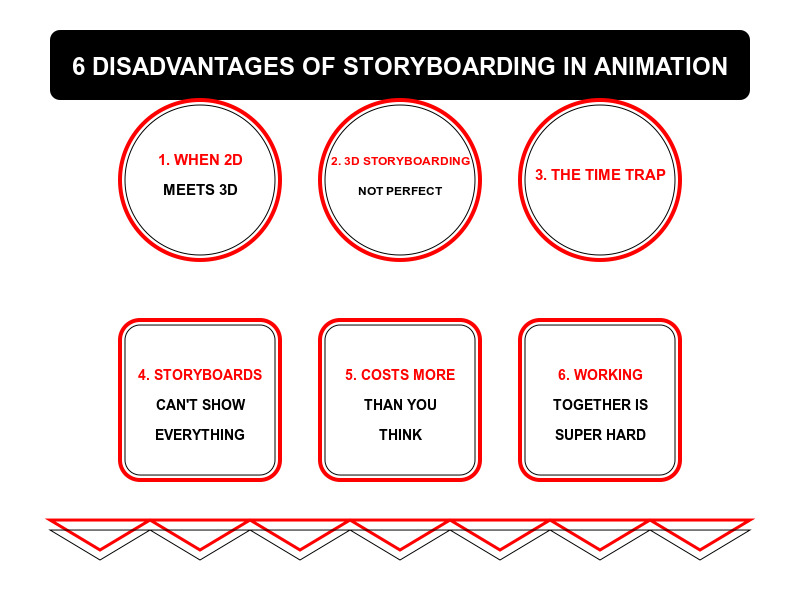
1- When 2D Meets 3D: The Headaches
Gouvatsos (2018) points out that jumping from old-school 2D storyboards to 3D animation creates some real headaches. These two approaches are just different enough to cause mistakes and slow everything down.
- Things Look Different in 3D: Characters and objects that seem perfectly proportioned on paper can end up looking totally off when built as 3D models.
- Style Gets Lost in Translation: That cool artistic style you nailed in your 2D storyboards? Yeah, good luck matching that exactly in 3D. This mismatch can make the final product look nothing like what you planned.
- Missing Technical Details: 2D storyboards rarely include the nitty-gritty technical stuff needed for 3D work such as exact camera positions, lens types, and lighting setups.
- Double the Work: Because 2D and 3D are so different, teams often have to redo everything rather than build directly from the storyboards. That means paying twice for the same creative work.
2- 3D Storyboarding: Not Perfect Either
Gouvatsos believes that 3D storyboarding can help with many issues, but he also lets it be known that it has some problems. These trouble spots need more work before the whole process goes smoothly.
- Artists Might Not Be Able to Do It: 3D storyboarding calls for technical skills that regular artists might not have. This could lead to delays or make businesses spend time and money on training.
- Too Early for Models: You have to make 3D objects earlier in the process, which can slow down the conception and planning stage.
- Uses A Lot Of Resources—3D storyboarding needs more computer power and maybe even more expensive specialty software than regular drawing.
- Style Clashes – Default animations often create inconsistent looks between different elements or scenes. The result? A final product that feels cobbled together rather than cohesive.
3- The Time Trap: Is Storyboarding Worth the Wait?
Let’s not pretend. At first, creating a storyboard takes a very long time. Sitting around drawing can be unbearable when you’re excited to start shooting. So, it’s reasonable to question whether this is worth the time and money since not all projects can afford or use it.
- A lot. Drawing: Storyboard panels can be as many as 2,000 for a movie. For each? It takes between 15 and 30 minutes to draw. That’s roughly 1,000 hours before you even turn on a camera!
- Keeps Putting Off Filming: Did you know that Christopher Nolan spent three months just drawing up the plot of “Tenet”? That is way too long just to plan!
- Could Be Making Stuff: Taking two weeks to make storyboards takes away 25% of your shooting time if you’re an independent director with only eight weeks to shoot. Not an easy choice, is it?
4- Storyboards Can't Show Everything
Absolutely, storyboards aren’t flawless. Even though they’re very helpful, they can’t show all the details, movement, and energy that will be in the final result. This difference between what you draw and what you get can make you scratch your head.
- Not nearly as detailed as the final product: Remember that famous shower scene from “Psycho“? There were only simple line drawings on the storyboards. As a result, they couldn’t show how intense the scene was by using dramatic lighting, splashing water all over the place, or timing the cuts just right.
- When the cameras roll, plans change: Steven Spielberg had storyboards for “Jurassic Park,” but don’t you know? As soon as they started shooting, they had to change what they had planned because of real problems and sudden artistic ideas.
- Can’t Really Show Cool Camera Moves: That great one-shot fight in the hallway in “Daredevil” started out as a bunch of still drawings. That scene made everyone go crazy, but those pictures couldn’t possibly show how difficult the dance and camera work was.
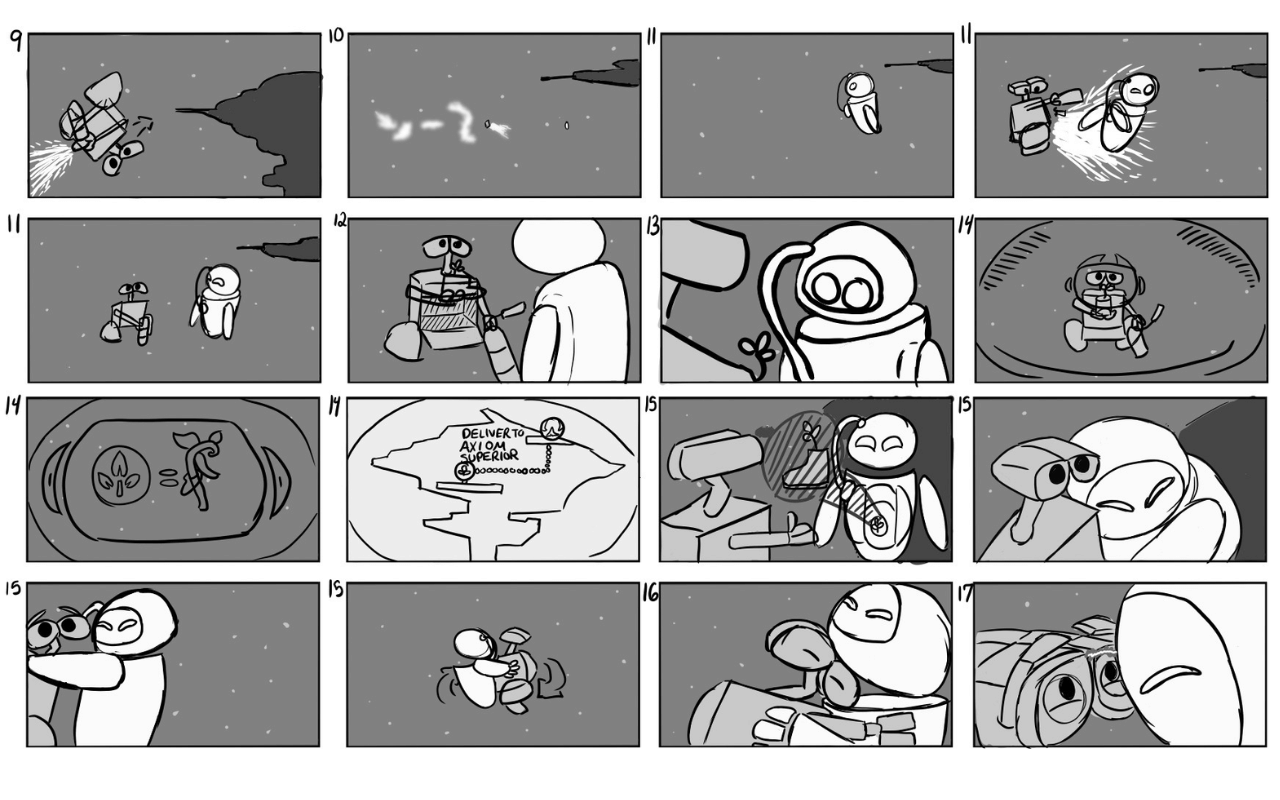
5- Storyboarding Costs More Than You Think
Animation storyboarding isn’t just about grabbing a pencil and paper. You need specific skills and tools that might cost extra or be hard to find.
- Need Real Artists for Traditional Boards: Professional storyboard artists charge $300-$800 PER DAY in the film industry. That specialized skill doesn’t come cheap!
- Digital Storyboarding Has a Learning Curve: Programs like StudioBinder or Boords take 2-4 weeks to learn properly. Nobody’s making good storyboards on day one.
- Software Costs Add Up: Professional storyboarding software subscriptions run $30-$90 monthly. That’s up to $1,080 per year just to make fancy drawings!
- Tools for the Whole Team Get Expensive: A company with five storyboard artists might drop $5,000-$10,000 every year on digital tools and software.
6- Working Together Is Super Hard
Storyboarding can make it harder for people to work together, especially when they are working from different places. It’s supposed that storyboards help people talk to each other better, but both real and complicated digital ones often make it harder for people to work together.
- Can’t Easily Share Paper Storyboards: Artists working on “The Mandalorian” in different places couldn’t just hand over their work. They had to scan and send everything, so they didn’t get a response for days.
- No Way to Work Together in Real Time: Teams from all over the world work with Netflix, but actual storyboards make everyone wait their turn to look over and give comments.
- Digital files cause tech problems: For example, app writers who use Xcode storyboards have to deal with awful merge conflicts where changing a small thing can affect hundreds of lines of code.
Bottom Line: Should You Use Storyboards?
It depends on what you’re working on. Storyboards are probably worth the trouble when there are a lot of people involved or when there are tricky technology issues. And, their benefits, like order and clear communication, are greater than their drawbacks.
You can choose a less serious method for jobs that are easier and where being free is more important. For best results, use simple storyboards that show the big picture but allow for creative editing on the spot.

